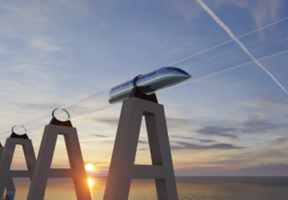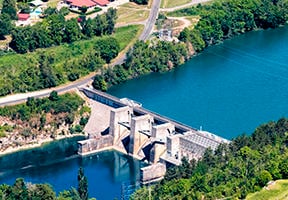The Car of Tomorrow: A Era of Individual Mobility
10 min read
Future solutions are always difficult to predict. Not only do they depend on technological advances, but often also on the economic environment, societal changes, public policy and competition among innovative industries. Automobiles are a good example of this complexity.

© SPENCER PLATT / AFP / GETTY IMAGES NORTH AMERICA - The dashboard of a Tesla Motors autonomous vehicle, unveiled in July 2016 in New York. For the moment, drivers can take back control of the vehicle if required.
The emergence in recent years of two megatrends – the digital revolution and the sharing economy – have led automakers to start thinking about the future of their industry in terms that reach far beyond regular technological upgrades to their models.
Digital Technology and "Autonomous" Cars
The exponential development of digital technology and big data have reopened the door to "autonomous" or "semi-autonomous" cars capable of getting around with little-to-no driver intervention1. Among the expected benefits are enhanced safety, reduced consumption, fewer traffic jams and, by extension, more free time.
The idea is not new. In 1977, Japan's Tsukuba Mechanical Engineering Laboratory performed the first tests on a dedicated circuit with road marking that could be read by the vehicle. Over the following years, increasingly sophisticated processes were trialed in Germany and the United States.
But the idea did not take tangible shape until the 2010s, when U.S.-based Google decided to capitalize on its high-level expertise in digital mapping. The ability to accurately define every inch of the environment is vital for guiding a vehicle and perfecting an autonomous driving system. Boasting precisely these digital skills, Google made a highly publicized announcement that it was launching a self-driving car. Rather than offering its know-how to traditional automakers on a silver platter, the tech giant chose to branch out into car manufacturing itself.
Automakers began their counteroffensive in 2014, almost unanimously announcing plans to market "autonomous" or "semi-autonomous" vehicles within five-to-ten years. In actual fact, they were not starting from scratch. Since the introduction of anti-lock braking systems (ABS) in 1978, they had continuously been fitting their vehicles with new driver assistance technologies, such as electronic stability control, cruise control, parking assistants, speed and lane-departure warning systems and geolocation. This required them to equip their cars with radars, sensors, cameras, scanners and microprocessors.
Generally speaking, automakers plan to move ahead with autonomous technology in a series of successive steps, starting with automated driving in traffic jams before extending the feature to strips of motorway and then city centers, all with the possibility of the driver taking the wheel if necessary. At the same time, fully autonomous vehicles are being tested as part of urban transportation networks and in closed areas, such as airports and amusement parks. Studies are also ongoing to extend the concept to warehouse and utility vehicles.
Toward a Car-Sharing Economy
Another factor that has revolutionized the automotive industry is the ability for individuals and professionals to enter into contact directly using new mobile technologies. Known as "uberization" (from tech company Uber), this development has given rise to new solutions ranging from car-sharing (such as Paris's Autolib' service), ride-sharing and peer-to-peer car rental, on the one hand, to new on-demand private driver services, on the other. As a result, vehicle ownership is being replaced by vehicle usership, meaning that automakers will no longer sell only a "number of vehicles" but also "miles traveled" in shared transportation systems. According to a report by financial institution Morgan Stanley, shared cars and on‑demand private driver services accounted for 4% of miles traveled in 2015, a figure forecast to rise to 26% by 20302.
The two revolutions are converging, with companies such as Uber taking a keen interest in autonomous vehicles as a means of cutting costs. In October 2016 in the United States, Uber tested its first delivery by an autonomous, driverless truck, over a distance of 200 kilometers.
External Factors Persist
One constant in the history of the automotive industry is the influence of non‑technological factors:
- The development of the production line and the expansion of consumer credit led to the rise of the car in the early 20th century, some 20 years after it was "technically" invented.
- Political visions for a "people's" car in Europe encouraged the emergence of small models in the late 1930s and post-war period, including the Volkswagen Beetle, the Fiat Topolino, the Citroën 2CV and the Renault 4CV.
- The economic prosperity of France's Trente Glorieuses (1945-1975) started a trend toward more up-market vehicles. Then the 1973 oil crisis led to a revival in "compact" cars with fuel consumption of 4 liters per 100 kilometers.
- The 1980s oil glut and resulting decline in prices ushered in an era of more powerful vehicles offering greater comfort. At the same time, vehicles grew heavier due to a heightened emphasis on safety. The combination of these demands pushed up fuel consumption.
- In response to environmental concerns, laws were introduced to regulate pollutant emissions and encourage the shift to hybrid and electric vehicles. Fuel-efficiency considerations have today prompted automakers to develop gasoline models that use 1 liter of fuel per 100 kilometers.






















